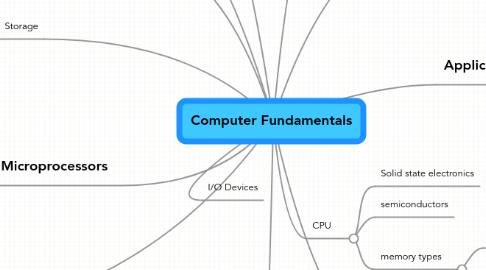Computer Fundamentals
Door Julian Manders-Jones


1. I/O Devices
2. Storage
2.1. optical
2.2. SSD
2.2.1. military applications
2.2.2. portable apps
2.3. Magnetic
2.4. RAID
3. Components
3.1. Graphics Cards
3.1.1. NVidea
3.1.2. parallel processing
3.2. Expansion Slots
3.2.1. PCMCIA
3.2.2. PCI
3.3. Specifications
3.3.1. iMac
3.3.1.1. OSX, GPU, CPU
3.3.2. iPad
3.3.2.1. iPhone OS
4. News, Trends & Developments
4.1. Tablet PC's
4.2. oLED's
4.3. Netbooks
4.4. Costs of Processors
4.5. Organic Systems
4.6. iPad
5. Types of Systems
5.1. Generations of Computers
5.2. Supercomputers
5.2.1. Brute Force
5.2.2. Parallel Processing
5.2.3. UNIX
5.2.4. Research & Development
5.2.5. ICT Department Personel
5.2.5.1. Systems Programmers
5.2.5.2. Expected Salaries
5.2.5.3. Systems Analysts
5.3. PDA, Smart Phones, Consoles, TV's
6. Research Skills
6.1. MLA Styles
6.2. IBD requirements
6.3. Plagiarism
6.4. Portfolio Criteria and Assessments
7. History of Computers
8. Microprocessors
8.1. machine language
8.2. addresses & instruction locations
8.3. program execution
8.4. Intel 8080 - Dual Core, Atom, AMD, Apple A4
8.5. Transistors
8.6. Assembly Language
8.7. CAM for Microprocessors
9. ALU
9.1. Basic binary
10. Control Systems
10.1. embedded systems
10.2. closed feedback cycle
10.2.1. New node
10.3. Sensors
10.4. Artificial Intelligence
11. CPU
11.1. Solid state electronics
11.2. semiconductors
11.3. memory types
11.3.1. cache
11.3.2. DRAM, Virtual Memory, Flash, Video, BIOS, SSD
12. Applications
12.1. iChat
12.1.1. AIM & Jabber
12.2. Web CMS
12.2.1. Joomla
12.2.2. Moodle
12.2.3. Copyleft
12.3. iWorks
12.3.1. Pages
12.3.2. Numbers
